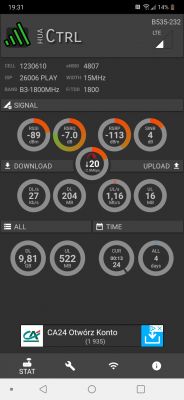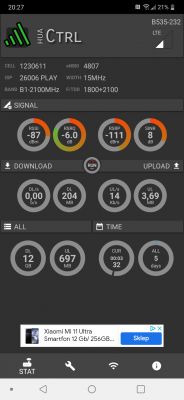

Czy wolisz polską wersję strony elektroda?
Nie, dziękuję Przekieruj mnie tam


rafalb76 wrote:Hello. Could you please tell me why several times in this thread it is stated that this or that router is not suitable for e.g. Playa? After all, routers do not have simlocks now and you insert a SIM card and use it. If I currently have a cat.4 LTE router and I want to change it to B535 from cat.6, maybe nothing will improve? I have no aggregation, I will have 2 bands with aggregation and I thought it would always do something. And here I read the thread and, for example, eeee, this router is not suitable for Play. What's this about? Of course, in short.
rafalb76 wrote:Thank you for the answers, a lot has lightened up. I am not a squeeze fan as much as I can, I just wish I wouldn't get stuck on, for example, Netflix or YouTube. I currently have transfers of about 2-10 download and 0.5-2 uploud - the lower values are peak hours, i.e. weekends in the evening, and the higher ones are normally during the day. The router stands anywhere, moving it gives little, shows a good range. The transmitter is Play ID: LGI3301 Borowa Góra - gm. Serock, ul. Lipowa - plot no. 94/4 (Cellnex tower - formerly owned) - this is info from Btssearch. I have 600m in a straight line to it, and I have over 2km to any other. I am not interested in external antennas and equipment for more than PLN 200, because I am waiting for the optical fiber, apparently something is already happening. I thought, first of all, about the aggregation of 2 bands, and secondly about the possibility of rigidly selecting which bands should be, and I think the B535 has such an option. I will measure every single strand available and rigidly set the two best ones. I will buy this router, of course, used and with the small antennas screwed on the back. The assumption is that it is noticeably better (e.g. no jamming in Netflix), to fit around PLN 200 and not to play with an external antenna, cables, etc.